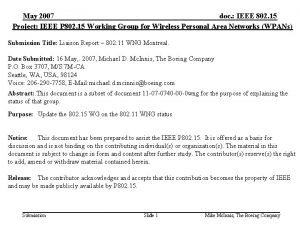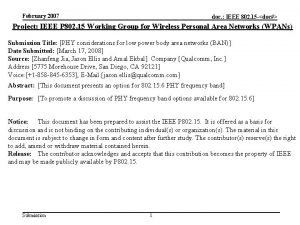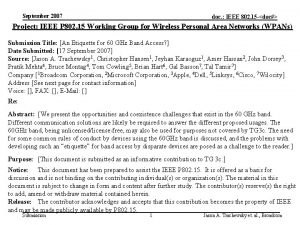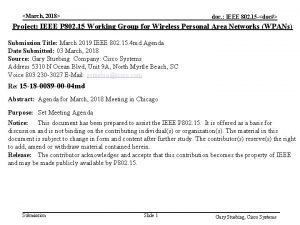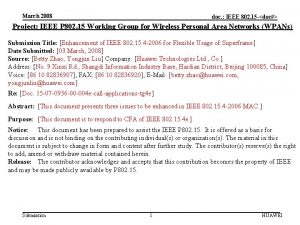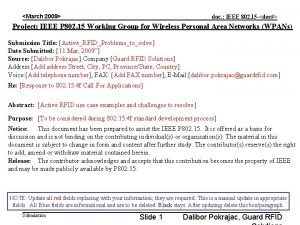March 2007 doc IEEE 802 15 doc Project









- Slides: 9

March 2007 doc. : IEEE 802. 15 -<doc#> Project: IEEE P 802. 15 Working Group for Wireless Personal Area Networks (WPANs) Submission Title: [Data rate back off modes for 802. 15. 3 c Alternate PHY] Date Submitted: [March 14, 2007] Source: [Bruce Bosco] Company [Motorola] Address [2100 East Elliot Road, Tempe, AZ, 85284, USA] Voice: [4804135241], FAX: [4804135453], E-Mail: [bruce. a. bosco@motorola. com] Re: [General] Abstract: [Presentation of need for and conceptual implementations of data rate back off modes of operation for 60 GHz PHY] Purpose: [Information and discussion of back off modes of operation] Notice: This document has been prepared to assist the IEEE P 802. 15. It is offered as a basis for discussion and is not binding on the contributing individual(s) or organization(s). The material in this document is subject to change in form and content after further study. The contributor(s) reserve(s) the right to add, amend or withdraw material contained herein. Release: The contributor acknowledges and accepts that this contribution becomes the property of IEEE and may be made publicly available by P 802. 15. Submission 1 Bruce A Bosco, Motorola

March 2007 doc. : IEEE 802. 15 -<doc#> Data rate back off modes for 802. 15. 3 c Alternate PHY Overview, discussion and recommendations Submission 2 Bruce A Bosco, Motorola

March 2007 doc. : IEEE 802. 15 -<doc#> Ø Back-off modes needed to maintain QOS: • Example: For streaming video, all paths are temporarily, sufficiently inhibited such that transmission at maximum data rate is not possible. The system would scale back to a lower data rate that would allow transmission at the required PER. The system would return to a higher, and ultimately, maximum data rate when the channel is available. • Example: For the Kiosk case, user is bumped or distracted and so on while receiving data, data rate could scaled back temporarily until higher rate is re-established. Submission 3 Bruce A Bosco, Motorola

March 2007 Ø Back-of doc. : IEEE 802. 15 -<doc#> modes needed to implement near term in portable devices: • Back-off modes are needed to realistically enable any portable, low cost device to meet standards requirement any time soon: a. Power consumption – huge issue b. Bus speeds won’t support multi-gigabit data rates c. Buffers are an option, but large buffers probably not realistic solution d. Drives and flash memory may be options but still not likely to handle multi-gigabit rates… Submission 4 Bruce A Bosco, Motorola

March 2007 doc. : IEEE 802. 15 -<doc#> • Tier I devices seen as primarily operating at base rate or above. • Tier II devices seen as primarily operating at base rate or below. • Tier II devices seen as near-term, entry-level devices. Could reach high volumes relatively quickly. Eventually, would evolve into Tier I devices, most likely in the 3 – 5+ year time frame. • However, to guarantee interoperability, establish common data rates up to and including the minimum as per 07 -0583 Systems Requirements and other documents (applies to less aggressive option only). Submission 5 Bruce A Bosco, Motorola

March 2007 Submission doc. : IEEE 802. 15 -<doc#> 6 Bruce A Bosco, Motorola

March 2007 Ø doc. : IEEE 802. 15 -<doc#> More aggressive “optimal” solution particularly in light of status of so-called competing technologies: • Optimal Solution: Base rate a. b. c. d. e. f. 3. 0 Gbps 2. 5 Gbps 2. 0 Gbps 1. 5 Gbps 1. 0 Gbps 0. 5 Gbps g. h. i. j. 1. 0 Gbps 0. 5 Gbps 0. 25 Gbps. 125 Gbps “Tier I” Common: 1. 0 Gbps 0. 5 Gbps “Tier II” Advantage: Probably near optimal for projected portable device roadmaps. “Tier II” devices compatible with USB 2 [1] and other data transfer protocols. 2 common data rates provide compatibility. Meets requirements of PAR. Disadvantage: “Tier II” devices have no mode of operation that meets 2. 0 Gbps… Submission 7 Bruce A Bosco, Motorola

March 2007 doc. : IEEE 802. 15 -<doc#> Ø Discussion: • MAC is set up already to handle multiple rates. I. E. 11, 22, 33, 44, 55 MHz • Exact implementation TBD. • Proposed rates, including common, are not rock solid at this point but are open to discussion. Ø Recommendations: • Further investigate merits of variable data rate systems • Strongly consider one or both proposed back-off modes or propose an alternate mode Submission 8 Bruce A Bosco, Motorola

March 2007 doc. : IEEE 802. 15 -<doc#> Ø References: 1. Sivaraman et al, “Optimizing handsets’ multimedia connectivity and performance”, EDN, March 6, 2007 2. Lee, “Capacity and Variable Data Rate for Wireless Communications”, Naval Postgraduate School. 3. Ci et al, “A Variable Data Rate Scheme to Enhance Throughput Performance of Wireless LANS”, University of Nebraska- Lincoln 4. Ammer et al, “The Energy-per-Useful-Bit Metric for Evaluating and 5. Optimizing Sensor Network Physical Layers”, IWWAN ’ 06. Submission 9 Bruce A Bosco, Motorola










